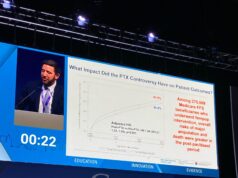AccessClosure announced results from the first study comparing the pain associated with deployment of different vascular closure devices as the primary endpoint, the study was published in the March edition of the Journal of NeuroInterventional Surgery.
The single-blinded, randomised, single-centre, controlled trial compared the discomfort associated with the Mynx 5F Vascular Closure device versus the Angio-Seal Evolution device. Both pain at closure and the pain increase from baseline to closure were significantly higher in patients undergoing closure with the Angio-Seal Evolution device (p=0.009 and 0.002, respectively). There was no difference in the rate of closure success or closure complications between the devices.
“This is an important study for physicians and patients,” said Gregory D. Casciaro, president and CEO of AccessClosure. “The study scientifically examined whether the Mynx device reduced the pain associated with arteriotomy closure seen with the Angio-Seal Evolution device and provides an evidence-based understanding that will help guide choice about vascular closure device options.”
The Institutional Review Board-approved study provided for enrolment of 128 patients based on power analyses with the intention of performing preliminary statistical analysis following enrolment of 64 patients (32 patients in each arm).
Patients, nurses administering a commonly utilised, well-validated visual analog scale to assess patient pain, and study coordinators were blinded to the vascular closure device treatment. The primary end point was defined as the change in pain from baseline (pre-closure) to post-closure, assessed by the vascular closure device. The patient’s reporting of the most painful part of the procedure from a multiple choice selection (1. Lidocaine injection and access, 2. contrast injection and 3. closure) was a secondary endpoint along with major and minor adverse events associated with vascular closure device and closure.
As pre-specified, enrolment was terminated following analysis of the first 64 patients enrolled because of the statistically significant difference in comfort detected.
The reduction in pain favoring the Mynx device compared to the Angio-Seal Evolution device was highly significant for both primary and secondary endpoints, which measured the pain at closure and the change in pain from baseline (pre-closure) to closure. Over twice as many patients undergoing closure by Angio-Seal closure as those undergoing Mynx closure reported the most painful part of the procedure to be vascular closure deployment (88% vs. 34%, p<0.001).
The large difference in pain experienced between Mynx and Angio-Seal patients was hypothesised to be secondary to the presence or absence of compression elements within the devices. No major or minor adverse events were reported in patients undergoing either Mynx or Angio-Seal closure procedures, although the study was not powered to detect a difference in adverse complications.
“Patient comfort is an important aspect in selecting a vascular closure device and every step taken to improve the patient’s experience is a step in the right direction,” said J Mocco, University of Florida College of Medicine, Gainesville, Florida, USA, co-author of the study.
About the Mynx Vascular Closure device
The Mynx device is indicated for use to seal femoral arterial access sites while reducing times to haemostasis and ambulation in patients who have undergone diagnostic or interventional endovascular procedures utilising a 5F, 6F or 7F procedural sheath. The Mynx device has not been approved for the reduction of pain in vascular closure procedures.
This device utilises an extravascular water-soluble polyethylene glycol (PEG) sealant that is gently deployed at the surface of the femoral artery. Following deployment, the sealant immediately expands sealing the common femoral artery and tissue tract. The sealant dissolves within 30 days, leaving nothing behind but a healed artery.
The Mynx received its first FDA approval in May 2007, has been used in over 750,000 procedures, and is available in two sizes for 5F and 6F/7F procedural sheaths.













